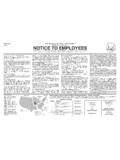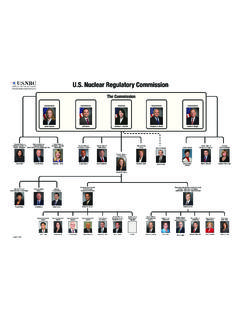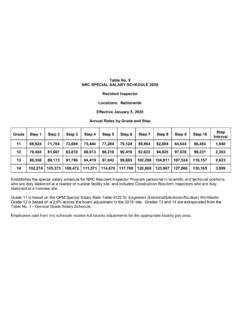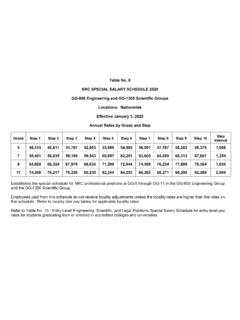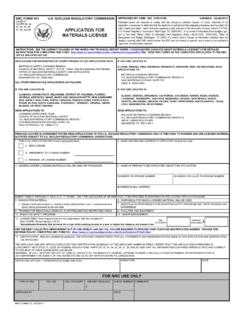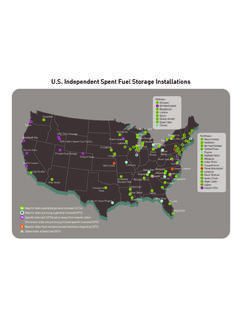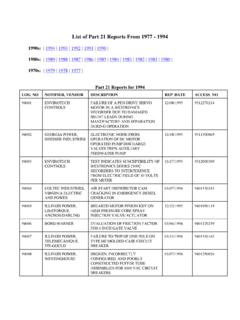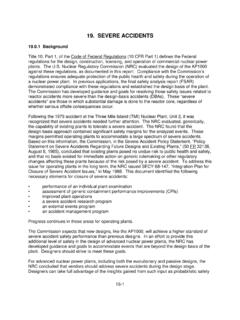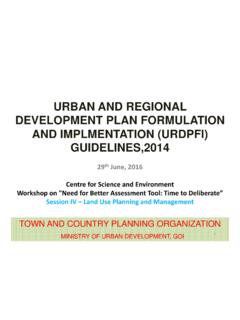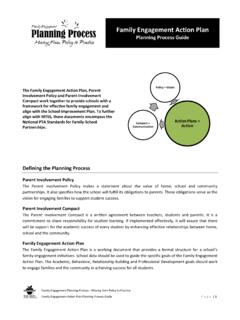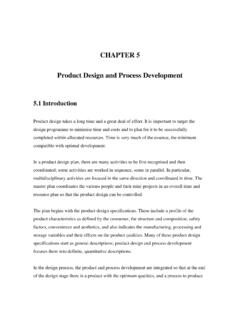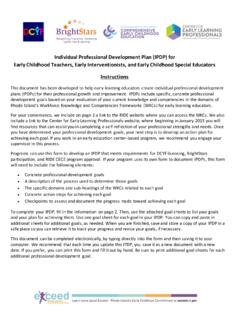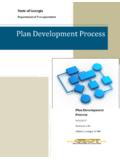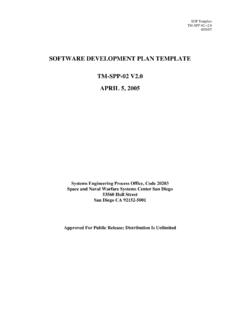Transcription of The Individual Development Plan (IDP) Process
1 The Individual Development plan (IDP) Process An Employee's Guide for Individual Development Career Planning The Individual Development plan | 1. The Individual Development plan (IDP) Process An Employee's Guide for Individual Development Career Planning The Individual Development plan (IDP) Process An NRC Employee Guide for Individual Career Development Planning Table of Contents Purpose of this Guide 1. What Are IDPs? 2. How do I Complete My IDP? 5. Step 1 Understanding Where You Are and Identifying Where You Want To Be 5. Step 1A Self-Assessment Questionnaire 6.
2 Step 2 Identifying Long-Range and Short-Range Professional Goals 10. Step 3 Identifying Your Developmental Objectives 11. Step 4 Meeting with Your Supervisor to plan The IDP 12. Step 5 Researching and Identifying Learning Opportunities That Address Your Developmental Objectives 12. Step 6 Drafting the IDP 13. Step 7 Meeting with your supervisor to finalize the IDP 15. Examples and Definitions of Developmental Activities 15. Ten Things to Remember when Developing IDPs 17. Ten Ways a Supervisor Can Help an Employee Develop and Implement an IDP 18.
3 My IDP Checklist 19. Sample IDP Form 20. Sample IDP Form with Suggestions 21. Purpose Of This Guide The NRC Training and Development Strategic plan lists as its first goal: Individual Performance Ensure that training and Development opportunities enhance Individual performance and support continuous learning at all levels.'. It also identifies the following as one strategy for reaching that goal: Encourage the use of Individual Development plans (IDPs) to guide Individual training and Development activities.'. The IDP Guide supports both this goal and strategy by providing information to both employ- ees and their supervisors on the importance of the Individual Development plan Process to em- ployee career growth, Development and performance as well as long-term agency effectiveness.
4 It also provides step-by-step instructions on how to prepare an IDP as well as additional resourc- es, tools and tips designed to ensure the Development of a meaningful IDP; one that supports an employee's career goals and aspirations as well as the agency's mission. Who Should Read This Guide? Regardless of your current position within the agency, this guide is a must read.. It can be used by managers to begin the conversation with staff about the importance and Development of an effective IDP. It can be used by staff members to, not only develop an effective IDP, but to help clarify career goals.
5 It provides an Individual the opportunity to reflect and answer the questions: Where do I want to be 5 years from now? &. What do I do to get there? The Individual Development plan | 1. What Are IDPs? Roadmaps to the Future IDPs are written schedules or plans designed to meet your particular goals for Development . Using an IDP is a systematic way of planning for training and gaining experience in order to develop the specific skills and knowledge you may need. Rather than haphazardly spending time and financial resources on what may or may not be useful activities, the IDP gives both you and your supervisor the opportunity to set some developmental objectives and engage in those experiences that will support these objectives.
6 Think of an IDP as a career roadmap, a way to assess where you are right now; determine where you want to go and how to get there. Consider it as a living document and use it regularly to keep a record of completed developmental activities and to reflect any changes in your work assignments needs or goals. If you change positions within or outside your agency, take your IDP with you and adapt it to your new position. Destination (GOALS). Developmental Objectives Developmental Objectives Developmental Objectives You are Here (Current position's job skills).
7 Developmental activities are the foundation for achieving your developmental objectives. 2 | The Individual Development plan An Opportunity to Reflect and Learn When was the last time you sat down and assessed where you are professionally and where you want to be? IDPs can be used to plan your training and employment related developmental learning experiences such as rotational assignments, special projects, job-sharing activities, internal training courses, and external training courses. An IDP can change from year to year. Its primary purpose is to help: n Assess your particular strengths, n Set reasonable goals, Provide you an outline of activities needed to move you towards the full n.
8 Performance level of your current position, and;. nProvide a framework for Development for a future position. A Partnership between Employee and Supervisor IDPs are extremely valuable because the Process includes both your viewpoint and that of your supervisor. This Process is a chance for your supervisor to find out about your goals and how you see yourself in the organization. It also implies a responsibility on your supervisor's part: in order to get a true picture of your career possibilities, you need information on your organization's long-and short-range plans, its staffing needs, its need for particular skills, and what career ladders exist or are planned.
9 You need feedback, too, on your strengths and weaknesses and goals. Your developmental goals are considered in so far as they are mission related and or congruent to your branch office work product priorities. An employee's supervisor is a key partner in the Development and successful implementation of an employee's IDP. IDPs are Not: Fixed in Stone Provided you and your supervisor agree, you can go back and change your goals and activities to reflect changes in your current position or future aspirations. Employee Performance Appraisals A performance appraisal looks back on past performance.
10 An IDP is an action plan that looks forward. Promises If conditions change ( time, deadlines, availability of training and budget changes) you and your manager can develop a plan B to pursue your goals. The Individual Development plan | 3. The IDP Process is about answering the following questions: Where am I now? Conduct a self-assessment to determine current skills, interests, and values. In addition to an assessment of current job strengths and areas for improvement, ask questions such as: What do I value? How satisfied am I in my current job?
